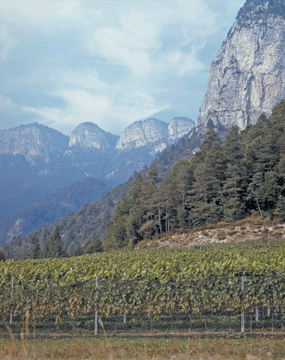
Tiefenbrunner’s Feldmarschall Vineyard, the highest vineyard in Europe.
Text and photos ©2010
Tucked away in a steep-sided narrow valley in the Northeastern part of the country, Alto-Adige seems a world apart from the rest of Italy. It’s almost unknown to American tourists who stick to more traveled roads, though it’s a popular destination with German and Austrian tourists who find hiking vacations a tonic to the stresses of modern life. For those of us who would rather dispel the stress over a bottle of fine wine, this is also a delightful vacation getaway.
Culturally, Alto-Adige (AHL-toh AH-deejay) has a split personality. Having been part of Austria for almost a millennium, it was ceded to Italy as part of the reparations for World War One. Most of the population still speaks German, and the towns go by two names (e.g. Bolzano-Bozen, Termeno-Tramin, Appiano-Eppan). The region itself is known by two names: Alto-Adige (High Adige, referring to the Adige River), and Süd Tirol (South Tyrol, referring to the southern Tyrolean Alps). The terms are used interchangeably.
Over dinner in a little mountain restaurant-farmhouse, I put the question directly to Urban von Klebelsberg, a tall man of 44 years with a square jaw and a shock of white hair. “Would Süd Tirol like to reunite with Austria? Afterall, it was part of Austria for something like 850 years, and has been part of Italy for only 90 years.” Urban, who is chief administrator of the Novacella Abbey (yes, he works for Augustinian monks) said, “We consider ourselves first South Tyroleans. Historically, others have tried to invade, from Germany to Napoleon, and we’ve always turned them away. We have a lot of autonomy within Italy, and anyway with the European Economic Union South Tyrol has become simply a part of Europe.” In other words, it’s not an issue. He also said that in Italy all South Tyroleans have a unique position. Italian speakers go to Italian schools, but their first language taught from kindergarten on is German. Conversely, German speaking families go to German schools and begin learning Italian in kindergarten. “I can speak German to a German speaker and I know what he is feeling; and I can speak Italian to an Italian speaker and know what he is feeling. Not just the words. The feeling, the soul of the person. It’s really unique.”
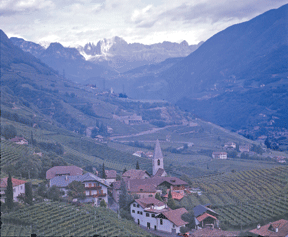
Vineyards above Bolzano-Bozen
Imagine Yosemite Valley carpeted with apple trees and vines stretching as far as the eye can see, and you have some idea of what makes the Alto-Adige so unique and so special. Granite escarpments, lush forests, castles perched on cliffsides, and tall steepled churches all add to the alpine charm. Wine touring is easy, as most wineries welcome visitors.
Aside from the inherent beauty of the region, part of the appeal of wine touring lies in discovering how the wines reflect the special terrain and climate of their place of origin. 12,750 acres of vineyards cover the valley floor (at 650 feet above sea level) and the slopes up to 3,250 feet a.s.l., of which 46% are planted to red varieties and 54% to white.
The wine culture here is in transition. Over the past 50 years the number of acres planted to grapes has been halved, from over 24,000 to the current 12,750, as apples have proven more lucrative than grapes — Alto Adige is the most prominent apple growing region in Europe. The average farm has 7.5 acres planted one-third to grapes and two thirds to fruit trees. Nonetheless, the past thirty years has produced a dramatic increase in the quality of the region’s wines, and 250 acres have been planted over the past decade.
About 35% of the region’s production is exported, most of it to Germany, the United States and Switzerland. Most of the red wine exports are destined for Germany, while exports to the U.S. are largely of the white varieties.
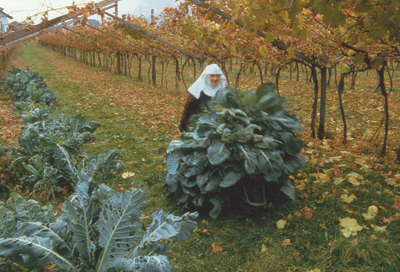
In November a nun pushes a wheelbarrow full of chard, harvested under the grape pergolas in Tramin.
Alto-Adige/Süd Tirol has a three thousand year tradition of grape growing. Today 18 varieties are grown here, of which three are indigenous: Vernatsch (also known as Schiava), Lagrein, and the illustrious Gewürztraminer. Unfortunately about half the wine produced in the area is from Vernatsch, which produces a rather innocuous red with a Beaujolais-like nose and bitter almond finish.
A decade ago the producers we visited repeated this line word for word: “Lagrein is the future of Alto-Adige.” I had a hard time not groaning every time I heard those words, as the Lagrein of the time was coarse and tannic in its youth, and seems to gain very little in the flavor profile with age. In the intervening years producers have tamed the tannins and today’s Lagrein is a delightful red with flavors of very ripe cherry to black plum and sweet spices.
While Alto-Adige’s winemakers sell tons of Vernatsch and praise Lagrein, most seem almost oblivious to the region’s strengths. Their Gewürztraminer, Pinot Blanc, Sauvignon Blanc and Pinot Noir are among the world’s best. These are truly exciting wines which show the potential of Alto-Adige.
If you have the fortune to travel to this part of the world, there are 15 cooperatives, 40 larger wine estates, and over 100 small growers who produce their own wine. If you can’t visit, you can take an armchair tour with some of the wines. Forty wineries now export to the United States. Here are five of the best:
MICHAEL-EPPAN
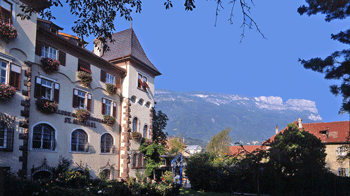
The St. Michael Eppan (or San Michele Appiano) winery under the looming Dolomites.
Cask carving is a traditional art form in Alto-Adige, to the extent that touring a cellar is often more like going to art museum than a winery. Even if you’ve seen enough cellars to last you a lifetime, don’t miss a chance to see these beautiful carvings. Some of the best are to be found at Cantina Produtorri S. Michele Appiano (or St. Michael-Eppan) in Eppan-Appiano, a beautiful old winery under chestnut trees in the shadow of the Mendola escarpment. Cellar Master Hans Terzer crafts exquisite whites, including my all time favorite Sauvignon Blanc under the Sanct Valentin label. At around $45 it’s not cheap, but it’s worth every penny.
TIEFENBRUNNER
Herbert Tiefenbrunner and his son Cristof are winemakers at their family estate of Schloss Turmhof, in the tiny village of Kurtatsch-Cortaccia. The castle, a couple hundred feet above the valley floor, was built in the 12th century and has been passed down through the generations. Wine has been made here since the founding, and the original wooden screw press with an arm the size and length of a good sized tree, was in use until the 1960’s! It has now been moved out of the cellar for tourists to admire. The “modern” winery was founded in 1848, and renovated in the early 1970’s when Herbert turned form selling wine anonymously in bulk to bottling his own estate wines. About 20% of the 50,000 case production is exported to the United States. 70% of production is of white varieties. At 1,000 meters a.s.l., their Feldmarschall Vineyard in Fennberg is the highest vineyard in Alto-Adige; in one of the most beautiful settings in the world high above the valley floor it’s still dwarfed by the surrounding granite peaks.
Tiefenbrunner makes a range of wines under the Tiefenbrunner, Castle Turmhof and Linticlarus labels. I was most impressed by their Linticlarus Chardonnay, exceptionally complex, velvety and long; and by the Linticlarus Cabernet Sauvignon, a well-structured wine of deep cassis and ripe blackberry character. Also worth noting was the Feldmarschall Müller Thurgau, and Kirchleiten Sauvignon [blanc].
ALOIS LAGEDER
In contrast to castle Turmhof, which exudes old world tradition, the Alois Lageder (lay-GAY-der) winery in Magreid-Magrè is among the most innovative in all the world. The 14 meter high cylindrical fermentation tower would be right at home in a James Bond thriller, a high tech wonder that looks as much like a missile silo as a winery, where the grapes and juice are fed from one level to the next by force of gravity. “We have a lot of technology,” says Alois Lageder, 59, namesake and great grandson of the founder. “But in the end I wanted to vinify the grapes naturally, with a minimum of pumps.” Solar panels on the roof supply 25% of the winery’s electrical energy.
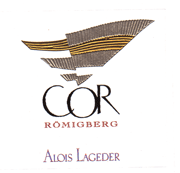
Lageder is among the most-progressive and high profile of the local vintners He’s been at the forefront of changing vineyard practices, moving away from the traditional pergola system of trellising, and experimenting with organic farming. “With our new high density planting and low yield, we will do much better,” says Lageder. He was also a leader in bringing a judicious amount of small French oak barrels into the winemaking regimen.
Lageder’s brother-in-law, Luis von Dellemann, is enologist, turning out about 80,000 cases under the Lageder label and another 10,000 under the single estate Hirschprunn label. French varieties are his specialty, as evidenced by the quality of the Pinot Nero and Pinot Bianco. Also impressive is the Lageder Löwengang Cabernet, a Bordeaux-style blend, and the Cason Hirschprunn, a field blend of Merlot, Cabernet Franc, Cabernet Sauvignon, Petit Verdot, Lagrein and Syrah.
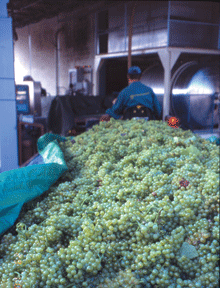
Grapes awaiting the crusher in Alto-Adige
COLTERENZIO
As so many of the Alto-Adige cooperatives illustrate, there is no intrinsic reason why a co-op’s wines should be of any lesser quality than any other winery. Colterenzio’s winemaker since 1999, 37-year-old Wolfgang Raifer, points out that the price they pay member growers for grapes depends not on quantity but on quality. His wines stand up with the best of the region.
Founded in 1960 by 28 growers, Colterenzio has grown to a 340-member cooperative owning 1,200 acres. Perched high on the mountain above Bolzano-Bozen, in the little town of Cornaiano, where wine has been made for 2,000 years, Colterenzio is a thoroughly modern winery incorporating the use of stainless steel, traditional large oak casks, and some small French oak barrels from a dozen different coopers.
In keeping with the duality of cultures, Colterenzio is known in German as Schreckbichl, and you’ll occasionally see both names of the label. They make several different lines: value priced varietals under Classic label; single vineyard wines from old vines under the Praedium label; a red blend and white blend under the Koro label; a Cabernet Sauvignon and a Sauvignon Blanc from the Lafoa vineyard; and their finest varietals under the Cornell label.
ABBAZIA DI NOVACELLA
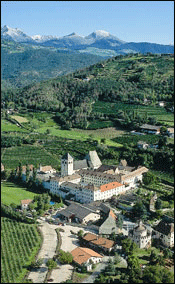
The Abbazia di Novacella is just below the Brenner Pass in Alto Adige, on the only road to Austria, photo courtesy of Abbazia di Novacella
Italy’s most northerly vineyards grow in the narrow gorge far up the Isarco River, around an Augustine monastery known as Chorherrenstift Neustift in German, or Abbazia di Novacella in Italian. The monastery was so placed because it lies below the Brenner Pass on the only road to Austria.
This is cold country, with large swings of temperature between night and day. The vines here yield only white wines, including Sylvaner, Müller Thurgau and Gewürztraminer.
Whether you’re into wine touring, historical sights, or grand architecture, you’ll want to stop at the abbey. The abbey has been in continual use for 868 years and has always been a winery. Winemaking remains the main source of income for the monastery, and today the wines are crafted by Celestino Lucin, Italy’s 2009 winemaker of the year. The monastery owns 45 acres (37 in relatively warmer areas around Bolzano-Bozen, 23 miles south, and Lago di Caldaro where their Lagrein, Schiava and Pinot Nero are grown) and control 123 more, for an average annual production of 33,000 cases.
The basilica, founded in 1142, took several centuries to complete, so the architecture and adornment covers the gamut from Romanesque to Baroque and Rococo. It remains one of the best-preserved ancient buildings in Italy. Its library is also the repository of some of the most beautiful illuminated manuscripts of the Middle Ages.
HOFSTÄTTER
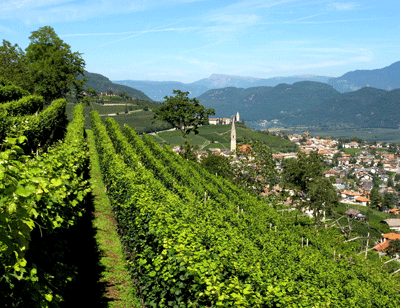
Vineyards just above Tramin, photo courtesy of J. Hofstatter
Hofstätter is located on the main square of Tramin, the village most famous for having given its name to Gewürztraminer. So it should come as no surprise that Hofstätter’s Gerwürztraminer is a perennial favorite. Owned by the Foradori family and managed today by winegrower Martin Foradori, J. Hofstätter has 125 acres of vineyards spread across five estates with historic manor houses located on both sides of the Adige river.Hofstätter’s Barthenau estate, on the slopes directly across the valley from Tramin, produces the best Pinot Nero in Italy, rivaling the best that Burgundy has to offer.
Where to Stay
Depending on where you find yourself in Bolzano-Bozen, it’s either a stark modern city with warehouses and manufacturing plants, or else a quiet city with quaint shops and charming architecture. I strongly suggest you stay in the old town section with its 14th century Romanesque-Gothic cathedral, arcades, and frescoed buildings. The city itself is at the base of tall mountains in the crux of a Y formed by the confluence of the Adige and Isarco rivers. People come here to hike and enjoy the fresh mountain air. hotels of the area tend to be pleasant, but rustic rather than luxurious. Here are a few recommendations:
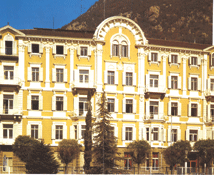
Hotel Scala Stiegle in Bolzano is next door to the St. Magdelena Winery
Hotel Scala Steigle
Via Piave
Bolzano-Bozen
tel: 0471 97 62 22
fax: 0471 98 11 41
http://www.scalahot.com/en/information/index.asp
Built around the turn of the 20th century, this hotel is located at the edge of the old town where it backs up against the terraced vineyards of St. Magdelena (known for its fruity red wine made from the Vernatsch grape). St. Magdelena Winery abuts the hotel. It’s two blocks from the funicular and train station, and within easy walking distance of most of the major sights. There is a small pool, and an excellent restaurant with garden seating in the warmer months.
Hotel Mondschein-Luna
39100 Via Piave
Bolzano-Bozen
tel: 0471 97 56 42
fax: 0471 97 55 77
http://www.hotel-luna.it/en
Just a few blocks away from the Scala Steigle, this 140 room hotel has been owned by the Mayr family since 1798! It has beautiful tree-shaded grounds and a garden restaurant.
Hotel Regina
I-39059 Oberbozen
tel: 0471 34 51 42
fax: 0471 34 55 96
http://www.hotel-regina.it/en/
A 12 minute funicular ride up the mountain from Bolzano-Bozen will bring you to the tiny hamlet of Oberbozen (literally “over Bozen”), one of the quietest places on earth. From its perch at 6,000 feet above sea level, Hotel Regina has breathtaking Alpine views. It’s one of 45 “wanderhotels” spread throughout the mountains from Liechtenstein to Austria. There are two clay tennis courts and a large pool for the athletically inclined, and a restaurant serving typical Tyrolean cuisine.
Where to Eat
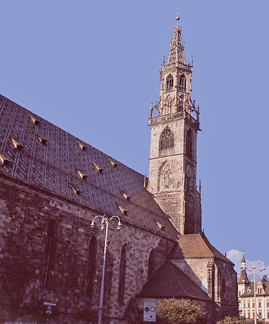
Bozen-Bolzano cathedral
Alto Adige has more Michelin stars (18) than any other region in Italy. With a population of
36,000 Merano/Meran, the second largest city in the region, boasts 3 Michelin-starred restaurants, including the two-star Trenkerstube in the 5-star hotel Castel, and the one-star restaurants Sissi, and the restaurant in the Hotel Castel FragsBurg. I’m sure these are all fine restaurants, worthy of your attention. Having not had the pleasure of dining at these establishments, I cannot give you a personal recommendation. I can, however, personally recommend these more humble dining venues that I know will please my fellow epicurean travelers.
Gasthaus-Albergo Zür Kirche
Fennberg-Favogna
tel: 0471 88 02 44
Far up in the mountains, with grand escarpments, little lakes and green meadows surrounded by evergreen forest, every bend in the road presents a perfect scene, a new surprise. I half expected to see Julie Andrews singing The Sound of Music. No such luck, but there were a few hikers in traditional lederhosen. The drive takes about 45 minutes from Bolzano-Bozen. Just past an Austrian-style church with its onion dome, you come to the Gasthaus-Albergo Zür Kirche, a popular inn with a very traditional and moderately priced menu. An 800-year-old Linden tree stands guard over the building, which looks like a Swiss chalet. The restaurant is crowded on the weekends, so it’s best to make reservations before making the drive, as there is no other restaurant in the vicinity. We had the area’s famous rye bread, beef stew with parsley and ham dumplings (canerderli), and apple torte.
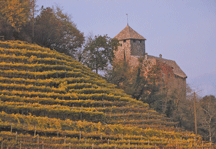
Gasthaus Zür Rose
Endergrasse 2
Kurtatasch-Cortaccia
tel: 0471 88 01 16
Warmed by traditional green-tiled wood-burning stoves, Chef Baldo Arno presides over this restaurant built in the 14th and 15th centuries. Chef Arno’s beef stew is so intense as to defy description, and the dried venison with horseradish, cranberry and rosemary is a treat you won’t find elsewhere.
Ristorante Bellavista – Marklhof
I-39050 Girlan-Cornaiano
tel: 0471 66 24 07
fax: 0471 66 15 22
Heinrich and Andreas Oberhofer present the regional cuisine with a flair. Of the dozen restaurant meals we had in the Alto-Adige, this was by far the best. The wild boar prosciutto (locally called spec) served with fresh figs was simply astounding. The food here is on a higher plan, the flavors, textures, and contrasts sublime. I had polenta topped with chanterelles and crumbled gorgonzola, which stood in bold relief to the palate cleansing lemon sorbet with vodka which followed. I pinched some cream puffs from one of my companions — so fresh they literally melted in my mouth. I waddled out under my own power, but I had to have a long nap to recover form my excesses.
& & &
